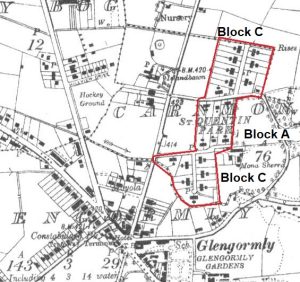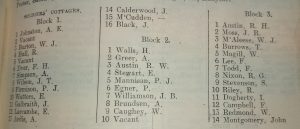Homes for Heroes in Glengormely
In the aftermath of the Great War, parliament passed the Irish Land (Provision for Soldiers and Sailors) Act in 1919 which provided for the erection of dwellings for ex-servicemen across the island of Ireland.
Nigel Henderson, a researcher with History Hub Ulster, has been documenting locations of the 1252 cottages built in Northern Ireland for war veterans between 1921 and 1939 under the auspices of the 1919 Act and the men who lived in the cottages. In the Whiteabbey/Glengormley area, 111 cottages were built under the auspices of the Act between 1922 and 1925. In 1922, one house was built in Ballyduff Townland and four cottages were built at the top of Whitewell Road. However, May 2023 marks the centenary of the completion of the cottages built at Glengormley. The centenaries of the colonies built at Cambrai Park and Ypres Park in Whiteabbey fall in January 2024 and March 2025 respectively. The British Legion built four cottages for ex-servicemen at Doagh Road, Whitehouse in the late 1920s.
 A colony of forty cottages, known collectively as St Quentin Park after the 1918 battle, was built in two phases in 1922 and 1923 on 10.5 acres of land purchased from Thomas Alexander Archbold of Hillview and Captain Robert Humphrey Bland of Tobarcooran for £1503-6-6, which equates to approximately 68,380 in current terms. Mr Archbold’s daughter, Jane Russell Archbold, had served with the Voluntary Aid Detachment as a Staff Nurse at the UVF Hospital in Belfast from January 1916 to February 1919. Captain Bland had served with the Royal Irish Rifles and the Labour Corps in the Great War. There were three cottage types in the colony with 38 semi-detached cottages and two detached cottages.
A colony of forty cottages, known collectively as St Quentin Park after the 1918 battle, was built in two phases in 1922 and 1923 on 10.5 acres of land purchased from Thomas Alexander Archbold of Hillview and Captain Robert Humphrey Bland of Tobarcooran for £1503-6-6, which equates to approximately 68,380 in current terms. Mr Archbold’s daughter, Jane Russell Archbold, had served with the Voluntary Aid Detachment as a Staff Nurse at the UVF Hospital in Belfast from January 1916 to February 1919. Captain Bland had served with the Royal Irish Rifles and the Labour Corps in the Great War. There were three cottage types in the colony with 38 semi-detached cottages and two detached cottages.
 Work commenced in August 1921 and the ten cottages at Block A were completed in September 1922. The fourteen cottages at Block C were completed in January 1923 and the sixteen cottages at Block B were completed on 11th May 1923. The average size of each plot was 0.26 acres which provided a sizeable area in which the veterans could grow fruit and vegetable and the initial rent was five shillings per week (approximately £11pw in current terms). The cottages did not have a water supply and four pumps supplied water to forty households. The first record of occupants of the cottages appears in the 1924.
Work commenced in August 1921 and the ten cottages at Block A were completed in September 1922. The fourteen cottages at Block C were completed in January 1923 and the sixteen cottages at Block B were completed on 11th May 1923. The average size of each plot was 0.26 acres which provided a sizeable area in which the veterans could grow fruit and vegetable and the initial rent was five shillings per week (approximately £11pw in current terms). The cottages did not have a water supply and four pumps supplied water to forty households. The first record of occupants of the cottages appears in the 1924.
These are the details on just two of the veterans who lived for a time at St Quentin Park.
Patrick Joseph Finnison was born in Leith and enlisted with the Royal Irish Fusiliers in October 1908 and was stationed with 1st Battalion at Woolwich in Kent in 1911. He was deployed to France on 22nd August 1914 and taken prisoner at Le Cateau five days later, being held at Limburg and Stendal camps. He was discharged in January 1919 and was living at Dandy Street in Whitehouse when he awarded a 40% Disablement Pension in respect of Neurasthenia at the rate of sixteen shillings per week (approximately £46 per week in current terms). He was employed as a Clerk when he married Agnes Canavan, a tailor, on 15th July 1919 at St. Mary’s Star of Sea Roman Catholic Church in Whitehouse. Patrick and Agnes Finnison later moved to Warrenpoint, where Patrick died on 28th November 1943, aged 49.
 Isaac Doherty was born on 5th July 1877 at Ballyfinaghy to Robert Doherty and Anne Doherty (nee McGowan) and he married Mary Graham of Drew Street on 5th September 1912 at St Anne’s Parish Church. Isaac enlisted with the Royal Inniskilling Fusiliers and was posted to France with the Ulster Division in October 1915. He was serving with the Royal Engineers when he was transferred to the Class Z Army Reserve on 8th May 1919. In 1928, Mary’s daughter from her first marriage, Lily Graham, died at the Royal Victoria Hospital at the age of 21. Isaac Doherty was living at 909 Crumlin Road when he died on 24th February 1940, aged 63, and Mary Doherty died on 7th May 1957, aged 80. Isaac and Mary Doherty and Lily Graham are buried in Dundonald Cemetery.
Isaac Doherty was born on 5th July 1877 at Ballyfinaghy to Robert Doherty and Anne Doherty (nee McGowan) and he married Mary Graham of Drew Street on 5th September 1912 at St Anne’s Parish Church. Isaac enlisted with the Royal Inniskilling Fusiliers and was posted to France with the Ulster Division in October 1915. He was serving with the Royal Engineers when he was transferred to the Class Z Army Reserve on 8th May 1919. In 1928, Mary’s daughter from her first marriage, Lily Graham, died at the Royal Victoria Hospital at the age of 21. Isaac Doherty was living at 909 Crumlin Road when he died on 24th February 1940, aged 63, and Mary Doherty died on 7th May 1957, aged 80. Isaac and Mary Doherty and Lily Graham are buried in Dundonald Cemetery.
Whilst many of the cottages have been extended or altered, with some of the semi-detached cottages being converted into single dwellings or business premises, it is still possible to see features of the original cottages. One pair of cottages have been demolished and replaced with Milibern Close, a housing complex for ex-service personnel. The support for service personnel continues, albeit in a different way.
Nigel Henderson, History Hub Ulster
